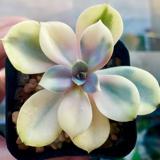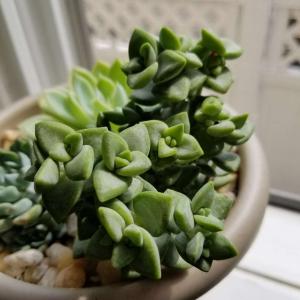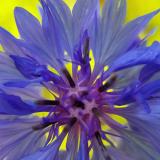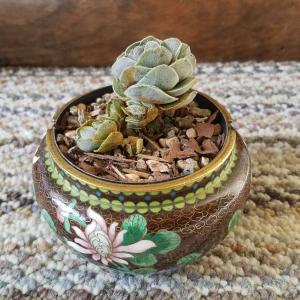文章
Miss Chen
2017年09月20日

La Crassula barbata recibe su nombre de la curiosa disposición de esas cerdas blancas que rodean los bordes de sus hojas. Aunque en principio pueda parecer un cactus en realidad se trata de una Crassulacea. Es originaria del sur de África y se puede encontrar con facilidad en diversas zonas de Sudáfrica, desde el sudoeste en el Great Karoo hasta el oeste en el Central Karoo.
Es una planta bienal o anual con hojas de unos 5 cm de largo y unos 4 cm de ancho que alcanza una altura alrededor de los 30 cm. En primavera se pueden ver unas pequeñas flores blancas que crecen en los tallos centrales de la planta y que alcanzan una altura de 15-20 cm. Tras la floración la planta muere aunque se suelen formar un buen número de rosetas basales que permiten propagar la planta con facilidad.

No es una planta difícil de cultivar aunque hay que tener mucho cuidado con el exceso de humedad pues se pudre fácilmente. Es también bastante susceptible a las cochinillas y las enfermedades fúngicas. Con la Crassula barbata, como con la mayoría de suculentas, es mejor pecar por omisión que por exceso con los riegos. Si tenemos un plato bajo la maceta donde tenemos a la planta lo vaciaremos de inmediato tras el riego para que no se quede el agua allí demasiado tiempo.

Es muy fácil de reproducir a partir de rosetas basales y también por esquejes de hoja. El suelo debe drenar rápido, usaremos pues un sustrato para cactus y suculentas. Necesita una localización muy luminosa pero la planta no debe recibir sol directo. Como vemos los cuidados son los comunes a todas las suculentas. La única precaución es no excederse con el agua.

La mejor época del año para su cultivo y reproducción es el otoño. Si cultivamos una Crassula barbata en una maceta o en el suelo es seguro que al cabo de pocos años tengamos una buena colección de ejemplares pues a pesar de morir tras la floración forma como hemos dicho un gran número de rosetas basales con las que se reproduce espontáneamente.
Es una planta bienal o anual con hojas de unos 5 cm de largo y unos 4 cm de ancho que alcanza una altura alrededor de los 30 cm. En primavera se pueden ver unas pequeñas flores blancas que crecen en los tallos centrales de la planta y que alcanzan una altura de 15-20 cm. Tras la floración la planta muere aunque se suelen formar un buen número de rosetas basales que permiten propagar la planta con facilidad.

No es una planta difícil de cultivar aunque hay que tener mucho cuidado con el exceso de humedad pues se pudre fácilmente. Es también bastante susceptible a las cochinillas y las enfermedades fúngicas. Con la Crassula barbata, como con la mayoría de suculentas, es mejor pecar por omisión que por exceso con los riegos. Si tenemos un plato bajo la maceta donde tenemos a la planta lo vaciaremos de inmediato tras el riego para que no se quede el agua allí demasiado tiempo.

Es muy fácil de reproducir a partir de rosetas basales y también por esquejes de hoja. El suelo debe drenar rápido, usaremos pues un sustrato para cactus y suculentas. Necesita una localización muy luminosa pero la planta no debe recibir sol directo. Como vemos los cuidados son los comunes a todas las suculentas. La única precaución es no excederse con el agua.

La mejor época del año para su cultivo y reproducción es el otoño. Si cultivamos una Crassula barbata en una maceta o en el suelo es seguro que al cabo de pocos años tengamos una buena colección de ejemplares pues a pesar de morir tras la floración forma como hemos dicho un gran número de rosetas basales con las que se reproduce espontáneamente.
0
0
文章
Miss Chen
2017年09月20日

Su nombre científico es Crassula Capitella subsp. thyrsiflora ‘Pagoda Village’ y ya nos indica que estamos ante un cultivar de una subespecie de Crassula Capitella. Especie que tiene su origen, como muchas otras plantas suculentas, en Sudáfrica, el auténtico paraíso de las crasuláceas.
Esta planta de color verde, morado o rojo, según variedades y cultivares es una gran adquisición para nuestra colección de suculentas. Destaca, como podéis ver, por su crecimiento geométrico formando estrellas apiladas de tamaño decreciente. No es muy grande, más o menos unos 25 cm de altura, y se puede cultivar en maceta.

Es una planta muy fácil de cultivar aunque algo sensible a las enfermedades fúngicas y a las plagas de cochinillas. Con la ‘Pagoda Village’ como con muchas otras suculentas vale más pecar de poco riego que de demasiado. Un exceso de agua puede hacer que sus raíces se pudran con gran facilidad. Hay que asegurarse, tras regarla, de vaciar el platillo de debajo de la maceta para que no se quede ahí el agua estancada.

Usaremos un sustrato con buen drenaje, el que venden para cactus nos irá perfecto. Y podemos iniciar nuestro ejemplar de Crassula Capitella a partir de un esqueje de hoja que hayamos tomado de otra planta. Como sabéis sólo hay que dejar la hoja u hojas sobre un plato o bandeja con sustrato para cactus humedecido y dejar que brote la plántula de la zona de corte de la hoja.

Cuando la plántula ya esté formada la cogeremos con cuidado, para no malbaratar las raíces, y la plantaremos en la maceta definitiva. Los cuidados básicos de esta suculenta son los mismos que los de cualquier otra similar. Luz indirecta siempre mejor que sol directo y agua sólo cuando el sustrato esté seco en su capa superior, unos 5 cm aproximadamente. Cuando crezca la planta y tengamos que cambiar de maceta recordad que hay que hacerlo con el sustrato bien seco. Revisad y limpiad las raíces y colocad en la maceta nueva, rellenad a continuación con sustrato nuevo y dejad una semana sin regar para que la planta se acomode al cambio.
Esta planta de color verde, morado o rojo, según variedades y cultivares es una gran adquisición para nuestra colección de suculentas. Destaca, como podéis ver, por su crecimiento geométrico formando estrellas apiladas de tamaño decreciente. No es muy grande, más o menos unos 25 cm de altura, y se puede cultivar en maceta.

Es una planta muy fácil de cultivar aunque algo sensible a las enfermedades fúngicas y a las plagas de cochinillas. Con la ‘Pagoda Village’ como con muchas otras suculentas vale más pecar de poco riego que de demasiado. Un exceso de agua puede hacer que sus raíces se pudran con gran facilidad. Hay que asegurarse, tras regarla, de vaciar el platillo de debajo de la maceta para que no se quede ahí el agua estancada.

Usaremos un sustrato con buen drenaje, el que venden para cactus nos irá perfecto. Y podemos iniciar nuestro ejemplar de Crassula Capitella a partir de un esqueje de hoja que hayamos tomado de otra planta. Como sabéis sólo hay que dejar la hoja u hojas sobre un plato o bandeja con sustrato para cactus humedecido y dejar que brote la plántula de la zona de corte de la hoja.

Cuando la plántula ya esté formada la cogeremos con cuidado, para no malbaratar las raíces, y la plantaremos en la maceta definitiva. Los cuidados básicos de esta suculenta son los mismos que los de cualquier otra similar. Luz indirecta siempre mejor que sol directo y agua sólo cuando el sustrato esté seco en su capa superior, unos 5 cm aproximadamente. Cuando crezca la planta y tengamos que cambiar de maceta recordad que hay que hacerlo con el sustrato bien seco. Revisad y limpiad las raíces y colocad en la maceta nueva, rellenad a continuación con sustrato nuevo y dejad una semana sin regar para que la planta se acomode al cambio.
1
0
文章
Dummer. ゛☀
2017年09月19日

Jade Plant (Crassula ovata) is a common houseplant that even the most novice of gardeners can grow successfully. Getting a Jade Plant to bloom requires mimicking its native growing conditions. Lack of water, cool nights and bright days encourage the plant to form buds and finally flowers. It’s a bit of a trick, but you can fool your plant into producing pretty little starry white to pink flowers in spring.
Jade Plants are primarily known for their thick, glossy, succulent leaf pads. These succulents reproduce by vegetative means but can also flower and produce seed. We often hear, “my jade plant won’t bloom,” and strive to provide information on what may cause a Jade Plant not flowering and how to promote blooms in reluctant plants.
Jade Plants grow for many years without blooming. Even in their native habitat, the plants need to be very mature before they form flowers. Among the many Jade Plant flowering requirements is an arid ambient environment. Interior conditions are often too humid for the plant to form buds.
Getting a Jade Plant to bloom will require you to remove it to a dry location, withhold water, and expose it to cooler nighttime temperatures. Of course, your plant should be an older species for blooming or you will still not find a single flower. Given the right setting and environment, a Jade Plant not flowering may simply be that it is not old enough to reproduce yet.
Getting a Jade Plant to Bloom
All plants need the same environment they would experience naturally to promote flowering and fruiting. Some require a dormancy period, some a photoperiod and others extreme environmental conditions.
Jade Plant flowering requirements are a combination of all three. The plant doesn’t exactly enter dormancy but it does require a rest period before buds form. As the days become shorter, reduce watering and do not fertilize.
Keep the plant in an area of 60 degrees Fahrenheit (12 degrees Celsius) during fall but protect it from any freezing. Blossoms should start to form around the shortest days of the year and bloom in late winter to early spring. These starry little flowers are produced in clusters at the tips of branches and are short lived.
Once the flowers fade and the stalk becomes brown, you can cut off the flowering stem. Begin to increase water and temperature as the spring progresses. In summer, move the plant outdoors gradually to an area with some protection from searing sun rays, but where it is bright for most of the day.
Water when the surface of the soil is dry. Jade plants like to be crowded, so they rarely need repotting to a larger container but they do need new soil every 3 years. Repot after the flowers have bloomed and at least a month before you move the plant outdoors for summer. Use a good cactus mixture for plants left indoors but add a bit of humus-rich soil to plants that are taken outside.
In spring to late summer, fertilize with a diluted balanced liquid fertilizer monthly. Don’t expect annual blooms, however, as the plant needs time to store adequate energy for this infrequent floral spectacle.

Jade Plants are primarily known for their thick, glossy, succulent leaf pads. These succulents reproduce by vegetative means but can also flower and produce seed. We often hear, “my jade plant won’t bloom,” and strive to provide information on what may cause a Jade Plant not flowering and how to promote blooms in reluctant plants.
Jade Plants grow for many years without blooming. Even in their native habitat, the plants need to be very mature before they form flowers. Among the many Jade Plant flowering requirements is an arid ambient environment. Interior conditions are often too humid for the plant to form buds.

Getting a Jade Plant to bloom will require you to remove it to a dry location, withhold water, and expose it to cooler nighttime temperatures. Of course, your plant should be an older species for blooming or you will still not find a single flower. Given the right setting and environment, a Jade Plant not flowering may simply be that it is not old enough to reproduce yet.
Getting a Jade Plant to Bloom
All plants need the same environment they would experience naturally to promote flowering and fruiting. Some require a dormancy period, some a photoperiod and others extreme environmental conditions.

Jade Plant flowering requirements are a combination of all three. The plant doesn’t exactly enter dormancy but it does require a rest period before buds form. As the days become shorter, reduce watering and do not fertilize.
Keep the plant in an area of 60 degrees Fahrenheit (12 degrees Celsius) during fall but protect it from any freezing. Blossoms should start to form around the shortest days of the year and bloom in late winter to early spring. These starry little flowers are produced in clusters at the tips of branches and are short lived.

Once the flowers fade and the stalk becomes brown, you can cut off the flowering stem. Begin to increase water and temperature as the spring progresses. In summer, move the plant outdoors gradually to an area with some protection from searing sun rays, but where it is bright for most of the day.
Water when the surface of the soil is dry. Jade plants like to be crowded, so they rarely need repotting to a larger container but they do need new soil every 3 years. Repot after the flowers have bloomed and at least a month before you move the plant outdoors for summer. Use a good cactus mixture for plants left indoors but add a bit of humus-rich soil to plants that are taken outside.

In spring to late summer, fertilize with a diluted balanced liquid fertilizer monthly. Don’t expect annual blooms, however, as the plant needs time to store adequate energy for this infrequent floral spectacle.
0
0
文章
Dummer. ゛☀
2017年09月19日

Crassula ovata is a succulent native to South Africa and is commonly called the Jade Plant or Money Plant. It has jade green, egg-shaped leaves and bears small pink or white flowers. The jade plant is a favorite indoor plant that can grow into a small tree or shrub up to 5 feet (1.5 m) tall, although it can be easily trained into bonsai form. It will grow outdoors in U.S. Department of Agriculture plant hardiness zone 10, but is better grown indoors in USDA zones below that where prolonged winter cold can kill it.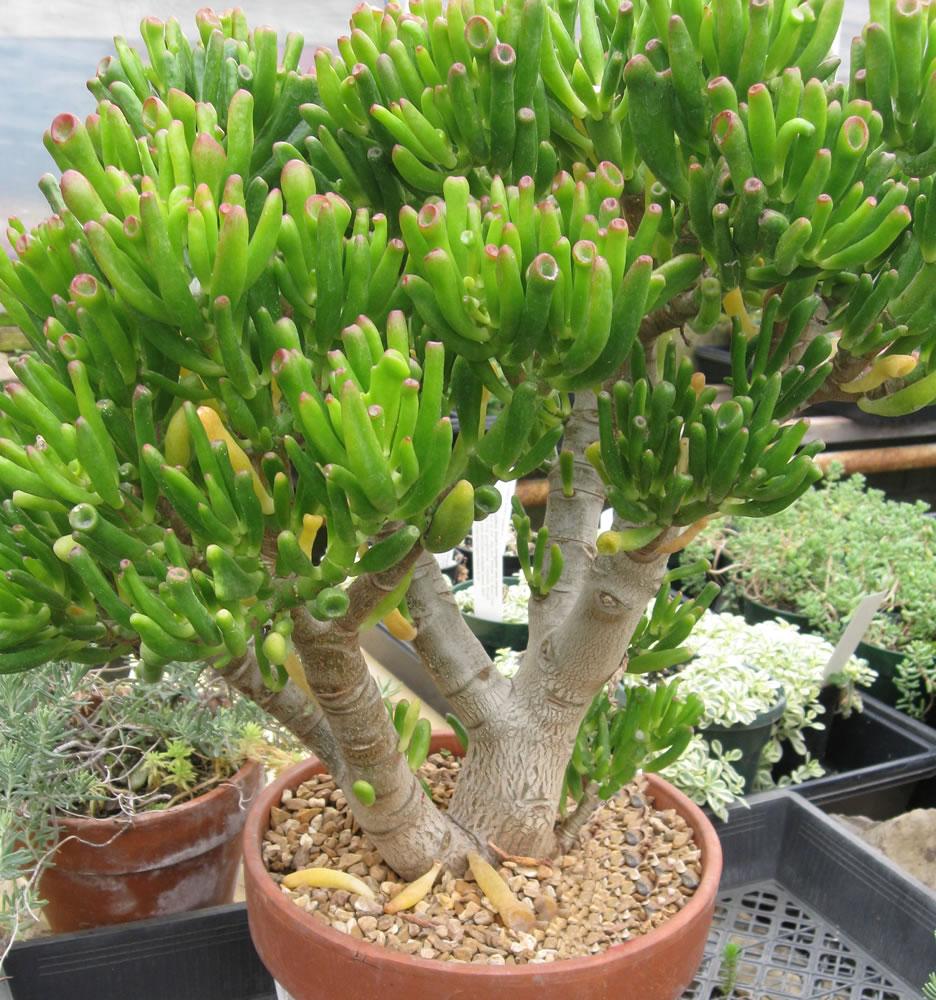
Problems With Growth
Jade Plants grown in pots can become root bound and top heavy causing them to tip over easily. Repot in the spring every two to three years or when it becomes top heavy. If you repot to the same size pot, prune the roots and stems to develop a thick main trunk. Do not overwater until the plant is growing well in the new container.
Problems With Sun and Temperature
A Jade Plant will grow in partial shade, but it needs sun to produce blooms. Overexposure to direct sun or heat can scorch the leaves. Do not put a Jade Plant behind glass in full sun. Too much heat can cause it to drop its leaves and the stems may begin to rot. Do not let its foliage touch cold window panes in the winter and protect it from drafts.
Watering Problems
A Jade Plant will withstand dry periods and will develop root rot if you leave it in soggy soil. This is a particular problem for jades grown in pots. Water sparingly when it is actively growing in the spring and summer. Let the soil dry between watering. Do not water in the winter. Drought can cause stunted growth and leaves to develop spots and drop, eventually killing it.
Pests
Mealybugs that look like small white puffs of cotton commonly infect jade plants. Insecticidal soap may damage the plant; instead, wipe them off with a cotton swab dipped in alcohol.
Spreading Problems
Although Crassula ovata is not listed on California’s list of noxious weeds, it spreads easily from leaves and pieces of stems that break off and grow. The Jade Plant grows wild in warmer wetlands and coastal areas and in many canyons near urban areas of Southern California. If you live in an area warm enough to grow it outdoors, ensure that you can contain its potential to spread.

Problems With Growth
Jade Plants grown in pots can become root bound and top heavy causing them to tip over easily. Repot in the spring every two to three years or when it becomes top heavy. If you repot to the same size pot, prune the roots and stems to develop a thick main trunk. Do not overwater until the plant is growing well in the new container.

Problems With Sun and Temperature
A Jade Plant will grow in partial shade, but it needs sun to produce blooms. Overexposure to direct sun or heat can scorch the leaves. Do not put a Jade Plant behind glass in full sun. Too much heat can cause it to drop its leaves and the stems may begin to rot. Do not let its foliage touch cold window panes in the winter and protect it from drafts.

Watering Problems
A Jade Plant will withstand dry periods and will develop root rot if you leave it in soggy soil. This is a particular problem for jades grown in pots. Water sparingly when it is actively growing in the spring and summer. Let the soil dry between watering. Do not water in the winter. Drought can cause stunted growth and leaves to develop spots and drop, eventually killing it.
Pests
Mealybugs that look like small white puffs of cotton commonly infect jade plants. Insecticidal soap may damage the plant; instead, wipe them off with a cotton swab dipped in alcohol.

Spreading Problems
Although Crassula ovata is not listed on California’s list of noxious weeds, it spreads easily from leaves and pieces of stems that break off and grow. The Jade Plant grows wild in warmer wetlands and coastal areas and in many canyons near urban areas of Southern California. If you live in an area warm enough to grow it outdoors, ensure that you can contain its potential to spread.
1
0
文章
Dummer. ゛☀
2017年09月19日

Jade Plant (Crassula ovata) are a classic houseplant, especially for the neglectful home owner. It prefer bright light and occasional water in the warm season, but other than that the plants are fairly self-sufficient. In good conditions, you may still find white spots on Jade Plant leaves; but if the plant’s overall health is good, you should not worry too much. What causes white spots on Jade Plant? It may be a natural phenomenon or a bit of a fungal disease, but either way, there are easy methods to define and deal with the problem.
What Causes White Spots?
The few times I have discovered white spots on my Jade Plant, I simply rubbed them off lightly and the plant was no worse for wear. The actual cause of the white spots on Jade Plant leaves might be powdery mildew, or even a condition where the plant stores salts and “sweats” the excess out through its leaves. One cause has a quick fix and the other requires some cultural adjustment and treatment. Both are really not all that harmful to your plant and learning how to get rid of white spots on Jade Plants is a matter of some quick steps.
Powdery Mildew
Most gardeners are familiar with powdery mildew. It occurs when there is low light, improper circulation, cooler temperatures and excess humidity. Overhead watering leaves foliage damp, which in winter months tends to stay moist for a long period. This promotes the formation of fungal spores that cause powdery mildew.
Avoid overhead watering and use a fan to increase circulation. Pinch off affected foliage and discard it. A solution of baking soda and vinegar is how to get rid of white spots on jade plants with powdery mildew. Spray on the leaves but ensure the leaves dry within a few hours.
Excess Salts
All plants uptake water through their roots with a few rare exceptions. Jade Plants store water in their fleshy leaves, which makes them ideal species in arid zones. They capture infrequent rainwater and store it until they need it much like a squirrel hoarding nuts. This gives the leaves their plump appearance.
Rain and ground water alike capture salt from the air and soil. When you water with a salty solution, the trapped moisture will go through the leaves during transpiration and the evaporated moisture will leave a salt residue on the leaf. Therefore, your Jade Plant has white spots on the surface of the pads. A soft, lightly moist cloth can wipe these away easily and restore the appearance of the foliage.
Other Reasons for White Spots
Jade Plants often get a condition called Oedema, where the roots take up water faster than the plant can use it. This causes corky blisters to form on the foliage. Reducing water should prevent the condition, but the blisters will remain.
Rarely, you may find a Jade Plant has white spots which are actually insects. Mealybugs have a whitish silver fuzzy exterior. If your white spots are moving under close observation, take action and seclude the Jade Plant from other plants.
The spots may also be a variety of scale with silvery bodies. Both can be conquered with a systemic insecticide formulated for houseplants or by dabbing them with a 70 percent solution of rubbing alcohol.
Jade Plants are not usually prone to insect infestations, but if you put the plant outdoors for the summer, take a good look at it before bringing it indoors and infecting your other flora.

What Causes White Spots?
The few times I have discovered white spots on my Jade Plant, I simply rubbed them off lightly and the plant was no worse for wear. The actual cause of the white spots on Jade Plant leaves might be powdery mildew, or even a condition where the plant stores salts and “sweats” the excess out through its leaves. One cause has a quick fix and the other requires some cultural adjustment and treatment. Both are really not all that harmful to your plant and learning how to get rid of white spots on Jade Plants is a matter of some quick steps.

Powdery Mildew
Most gardeners are familiar with powdery mildew. It occurs when there is low light, improper circulation, cooler temperatures and excess humidity. Overhead watering leaves foliage damp, which in winter months tends to stay moist for a long period. This promotes the formation of fungal spores that cause powdery mildew.
Avoid overhead watering and use a fan to increase circulation. Pinch off affected foliage and discard it. A solution of baking soda and vinegar is how to get rid of white spots on jade plants with powdery mildew. Spray on the leaves but ensure the leaves dry within a few hours.

Excess Salts
All plants uptake water through their roots with a few rare exceptions. Jade Plants store water in their fleshy leaves, which makes them ideal species in arid zones. They capture infrequent rainwater and store it until they need it much like a squirrel hoarding nuts. This gives the leaves their plump appearance.
Rain and ground water alike capture salt from the air and soil. When you water with a salty solution, the trapped moisture will go through the leaves during transpiration and the evaporated moisture will leave a salt residue on the leaf. Therefore, your Jade Plant has white spots on the surface of the pads. A soft, lightly moist cloth can wipe these away easily and restore the appearance of the foliage.

Other Reasons for White Spots
Jade Plants often get a condition called Oedema, where the roots take up water faster than the plant can use it. This causes corky blisters to form on the foliage. Reducing water should prevent the condition, but the blisters will remain.
Rarely, you may find a Jade Plant has white spots which are actually insects. Mealybugs have a whitish silver fuzzy exterior. If your white spots are moving under close observation, take action and seclude the Jade Plant from other plants.

The spots may also be a variety of scale with silvery bodies. Both can be conquered with a systemic insecticide formulated for houseplants or by dabbing them with a 70 percent solution of rubbing alcohol.
Jade Plants are not usually prone to insect infestations, but if you put the plant outdoors for the summer, take a good look at it before bringing it indoors and infecting your other flora.
0
0
文章
Dummer. ゛☀
2017年09月19日

Crassula ovata also known as Jade Plant is a succulent often used as a houseplant. This well-behaved plant blends into the landscape in USDA hardiness zones 9 through 11, where it thrives on neglect. Few pests or diseases affect Jade Plant, but when white powdery mold appears on its leaves, it is often the result of environmental problems. If you have white mold on your Jade Plant, you’re more likely dealing with powdery mildew. True to their easy-care nature, though, Jade Plants bounce back from powdery mildew once it is properly treated. 
Powdery Mildew
Powdery mildew is caused by several different fungi that grow in a thin layer on plant tissues. In perennial plants such as Jade Plant, the fungal bodies can overwinter in buds, re-emerging when conditions are ideal for their growth. Spores are often distributed by the wind to new, uninfected plants or spread in greenhouses from plant to plant. Temperatures between 60 and 80 degrees Fahrenheit (16 and 27 degrees Celsius) are required for germination, along with a relative humidity above 90 percent. Standing water on leaves is not necessary and can actually inhibit spore germination in some cases. Standing water encourages other fungal growth, through, so it should be discouraged.
Damage
Powdery mildew begins as a white powdery coating on the plant’s leaf surfaces, but soon spreads, penetrating plant tissues and sending out spores. Emerging vegetation may be dwarfed or distorted and covered in white mildew. Jade Plants also develop corky brown lesions where powdery mildew is taking hold. If not addressed, this mildew will spread farther, resulting in leaf drop and the eventual death of the Jade Plant.
Cultural Control
Cultural control is effective for powdery mildew. Plant Jade Plants in full sun and trim them to encourage better air circulation. Reduce watering if the plant’s soil is often moist; always allow the soil to dry before watering Jade Plants. Powdery mildew spores can be killed with water, but be careful to wet the plant early in the day so that it can dry completely. Stop misting house Jade Plants, instead water them at the base of the plant since humidity around the plant is what encourages the growth of powdery mildew.
Chemical Control
Several chemicals are available for chronically infested plants or those that are victims of environmental conditions beyond the control of the gardener. Test a safer pesticide such as horticultural or neem oil on a small spot on your Jade Plant before spraying the entire plant thoroughly. If an outside Jade Plant yellows or shows signs of sunburn, utilize a sunshade until signs of powdery mildew are gone to prevent serious damage. Never apply horticultural oils when temperatures are above 90 degrees Fahrenheit (32 degrees Celsius).

Powdery Mildew
Powdery mildew is caused by several different fungi that grow in a thin layer on plant tissues. In perennial plants such as Jade Plant, the fungal bodies can overwinter in buds, re-emerging when conditions are ideal for their growth. Spores are often distributed by the wind to new, uninfected plants or spread in greenhouses from plant to plant. Temperatures between 60 and 80 degrees Fahrenheit (16 and 27 degrees Celsius) are required for germination, along with a relative humidity above 90 percent. Standing water on leaves is not necessary and can actually inhibit spore germination in some cases. Standing water encourages other fungal growth, through, so it should be discouraged.

Damage
Powdery mildew begins as a white powdery coating on the plant’s leaf surfaces, but soon spreads, penetrating plant tissues and sending out spores. Emerging vegetation may be dwarfed or distorted and covered in white mildew. Jade Plants also develop corky brown lesions where powdery mildew is taking hold. If not addressed, this mildew will spread farther, resulting in leaf drop and the eventual death of the Jade Plant.

Cultural Control
Cultural control is effective for powdery mildew. Plant Jade Plants in full sun and trim them to encourage better air circulation. Reduce watering if the plant’s soil is often moist; always allow the soil to dry before watering Jade Plants. Powdery mildew spores can be killed with water, but be careful to wet the plant early in the day so that it can dry completely. Stop misting house Jade Plants, instead water them at the base of the plant since humidity around the plant is what encourages the growth of powdery mildew.

Chemical Control
Several chemicals are available for chronically infested plants or those that are victims of environmental conditions beyond the control of the gardener. Test a safer pesticide such as horticultural or neem oil on a small spot on your Jade Plant before spraying the entire plant thoroughly. If an outside Jade Plant yellows or shows signs of sunburn, utilize a sunshade until signs of powdery mildew are gone to prevent serious damage. Never apply horticultural oils when temperatures are above 90 degrees Fahrenheit (32 degrees Celsius).
0
0


